Fritz! 7430 Installation Manual
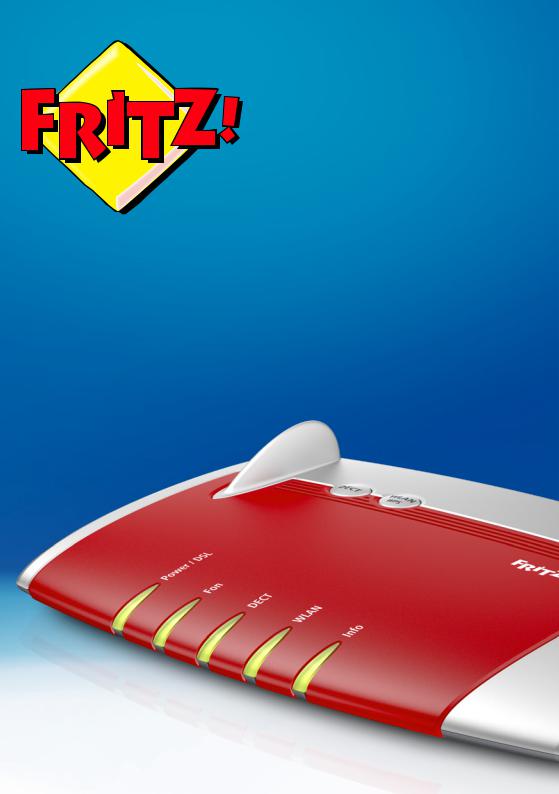
FRITZ!Box 7430
Configuration
and Operation

Table of Contents
Safety Instructions . . . . . . . . . . . . . . . . . . . . . . . . . . . . . . 8
Conventions in the Manual . . . . . . . . . . . . . . . . . . . . . . 10
1 The FRITZ!Box 7430 . . . . . . . . . . . . . . . . . . . . . . . . . . . . 11
2 Ports, Interfaces, Buttons and LEDs . . . . . . . . . . . . . . . 12
2.1 Ports and Interfaces. . . . . . . . . . . . . . . . . . . . . . . . . . . . . . . . . . . . . . 12
2.2 Buttons . . . . . . . . . . . . . . . . . . . . . . . . . . . . . . . . . . . . . . . . . . . . . . . . 13
2.3 LEDs . . . . . . . . . . . . . . . . . . . . . . . . . . . . . . . . . . . . . . . . . . . . . . . . . . 15
3 Before You Connect the FRITZ!Box . . . . . . . . . . . . . . . . . 17
3.1 Contents of the FRITZ!Box Package. . . . . . . . . . . . . . . . . . . . . . . . . . 17 3.2 Requirements for Operation . . . . . . . . . . . . . . . . . . . . . . . . . . . . . . . 17 3.3 Handling the FRITZ!Box . . . . . . . . . . . . . . . . . . . . . . . . . . . . . . . . . . . 18
4 Connecting the FRITZ!Box. . . . . . . . . . . . . . . . . . . . . . . . 19
4.1 Connecting to Electrical Power . . . . . . . . . . . . . . . . . . . . . . . . . . . . . 19 4.2 Connecting to the Internet. . . . . . . . . . . . . . . . . . . . . . . . . . . . . . . . . 19
5 Connecting a Computer with a Network Cable . . . . . . . 22
5.1 Connecting to the Computer . . . . . . . . . . . . . . . . . . . . . . . . . . . . . . . 22 5.2 Connecting a Network Hub or Switch . . . . . . . . . . . . . . . . . . . . . . . . 23
6Connecting Devices with the FRITZ!Box over
Wireless LAN . . . . . . . . . . . . . . . . . . . . . . . . . . . . . . . . . . 24
6.1 Establishing a Wireless LAN Connection Using WPS . . . . . . . . . . . . 24 6.2 Entering the Network Key on the Wireless Device . . . . . . . . . . . . . . 26 6.3 Connecting to Mobile Devices Wirelessly Using the QR Code. . . . . 27
FRITZ!Box 7430 |
2 |

7 The FRITZ!Box User Interface . . . . . . . . . . . . . . . . . . . . . 28
7.1 Opening the User Interface . . . . . . . . . . . . . . . . . . . . . . . . . . . . . . . . 28 7.2 Overview: FRITZ!Box at a Glance . . . . . . . . . . . . . . . . . . . . . . . . . . . . 28 7.3 Standard View and Advanced View . . . . . . . . . . . . . . . . . . . . . . . . . 30 7.4 Assigning FRITZ!Box a Name . . . . . . . . . . . . . . . . . . . . . . . . . . . . . . . 31 7.5 Tips for Passwords . . . . . . . . . . . . . . . . . . . . . . . . . . . . . . . . . . . . . . . 31
8 Password Protection: Using FRITZ!Box Safely . . . . . . . . 33
8.1 FRITZ!Box Password and FRITZ!Box Users . . . . . . . . . . . . . . . . . . . . 33 8.2 Configuring a FRITZ!Box Password . . . . . . . . . . . . . . . . . . . . . . . . . . 34 8.3 Using FRITZ!Box Users . . . . . . . . . . . . . . . . . . . . . . . . . . . . . . . . . . . . 35 8.4 Forgotten Password: What To Do . . . . . . . . . . . . . . . . . . . . . . . . . . . 42 8.5 “No login” Mode . . . . . . . . . . . . . . . . . . . . . . . . . . . . . . . . . . . . . . . . 43
9 Configuring an Internet Connection in the FRITZ!Box . . 44
9.1 Internet Connection for DSL . . . . . . . . . . . . . . . . . . . . . . . . . . . . . . . 44 9.2 Internet Connection for Cable . . . . . . . . . . . . . . . . . . . . . . . . . . . . . . 45 9.3 Configuring the Internet Connection for a Mobile Network. . . . . . . 45 9.4 Internet Connection over LAN 1: FRITZ!Box as a Router. . . . . . . . . . 47
10 Connecting Telephones and Other Terminal Devices . . 49
10.1 Registering FRITZ!Fon and Other Cordless (DECT) Telephones . . . . 49 10.2 Registering an iPhone or Android Smartphone . . . . . . . . . . . . . . . . 49 10.3 Connecting an IP Telephone . . . . . . . . . . . . . . . . . . . . . . . . . . . . . . . 51 10.4 Connecting a Door Intercom System. . . . . . . . . . . . . . . . . . . . . . . . . 51
11 Configuring the FRITZ!Box for Telephone Calls . . . . . . . 52
11.1 Configuring Your Telephone Numbers . . . . . . . . . . . . . . . . . . . . . . . 52
11.2Configuring Telephones and Other Terminal Devices
in the FRITZ!Box . . . . . . . . . . . . . . . . . . . . . . . . . . . . . . . . . . . . . . . . . 53
FRITZ!Box 7430 |
3 |

12 FRITZ!Box as an Internet Router . . . . . . . . . . . . . . . . . . . 54
12.1 Parental Controls: Access Profiles for Internet Use . . . . . . . . . . . . . 54
12.2Port Forwarding: Making Computers Accessible from the Internet. 63
12.3 Dynamic DNS: Name Instead of IP Address . . . . . . . . . . . . . . . . . . . 65 12.4 Access from the Internet via HTTPS, FTP and FTPS. . . . . . . . . . . . . . 66 12.5 Prioritization: Right of Way for Internet Access . . . . . . . . . . . . . . . . 67 12.6 VPN: Remote Access to the Home Network . . . . . . . . . . . . . . . . . . . 70 12.7 Freely Selectable DNS Servers . . . . . . . . . . . . . . . . . . . . . . . . . . . . . 72 12.8 DNSSEC: Security for DNS Queries . . . . . . . . . . . . . . . . . . . . . . . . . . 72 12.9 IPv6: The New Internet Protocol . . . . . . . . . . . . . . . . . . . . . . . . . . . . 73 12.10 Mobile Network: Replacing Faulty DSL . . . . . . . . . . . . . . . . . . . . . . . 75 12.11 LISP: FRITZ!Box as a LISP Router . . . . . . . . . . . . . . . . . . . . . . . . . . . . 76
13 FRITZ!Box as a Wireless Access Point . . . . . . . . . . . . . . 80
13.1 Switching the Wireless Radio Network On and Off by Schedule. . . 80 13.2 Extending a Wireless LAN Network . . . . . . . . . . . . . . . . . . . . . . . . . . 81
14 FRITZ!Box as a Telephone System . . . . . . . . . . . . . . . . . 83
14.1 Telephone Book . . . . . . . . . . . . . . . . . . . . . . . . . . . . . . . . . . . . . . . . . 83 14.2 Call List . . . . . . . . . . . . . . . . . . . . . . . . . . . . . . . . . . . . . . . . . . . . . . . . 85 14.3 Answering Machine . . . . . . . . . . . . . . . . . . . . . . . . . . . . . . . . . . . . . . 87 14.4 Fax Function . . . . . . . . . . . . . . . . . . . . . . . . . . . . . . . . . . . . . . . . . . . . 90 14.5 Call Diversion . . . . . . . . . . . . . . . . . . . . . . . . . . . . . . . . . . . . . . . . . . . 91 14.6 Dialing Rules for Outgoing Calls . . . . . . . . . . . . . . . . . . . . . . . . . . . . 92 14.7 Dial Around Service Using Dialing Rules . . . . . . . . . . . . . . . . . . . . . 93 14.8 Blocking Telephone Numbers and Callers . . . . . . . . . . . . . . . . . . . . 95 14.9 Do Not Disturb . . . . . . . . . . . . . . . . . . . . . . . . . . . . . . . . . . . . . . . . . . 96 14.10 Alarm . . . . . . . . . . . . . . . . . . . . . . . . . . . . . . . . . . . . . . . . . . . . . . . . . 96 14.11 Baby Monitor . . . . . . . . . . . . . . . . . . . . . . . . . . . . . . . . . . . . . . . . . . . 97 14.12 Making Telephone Calls with Convenience Functions. . . . . . . . . . . 99
15 Configuring FRITZ!Box on the Telephone . . . . . . . . . . . 103
15.1 Alarm . . . . . . . . . . . . . . . . . . . . . . . . . . . . . . . . . . . . . . . . . . . . . . . . 103 15.2 Do Not Disturb . . . . . . . . . . . . . . . . . . . . . . . . . . . . . . . . . . . . . . . . . 104 15.3 Call Diversion . . . . . . . . . . . . . . . . . . . . . . . . . . . . . . . . . . . . . . . . . . 104 15.4 Switching the Wireless Network On and Off. . . . . . . . . . . . . . . . . . 107 15.5 Loading Factory Settings . . . . . . . . . . . . . . . . . . . . . . . . . . . . . . . . . 107
FRITZ!Box 7430 |
4 |

16 FRITZ!Box as a DECT Base Station . . . . . . . . . . . . . . . . 108
16.1 Paging Cordless Telephones . . . . . . . . . . . . . . . . . . . . . . . . . . . . . . 108
16.2 Registering a Cordless Telephone. . . . . . . . . . . . . . . . . . . . . . . . . . 108
16.3 Deregistering a Cordless Telephone . . . . . . . . . . . . . . . . . . . . . . . . 108
16.4 Enabling DECT Eco . . . . . . . . . . . . . . . . . . . . . . . . . . . . . . . . . . . . . . 109
17 FRITZ!Box Connects Network Devices . . . . . . . . . . . . . 110
17.1 Network Settings in the FRITZ!Box . . . . . . . . . . . . . . . . . . . . . . . . . 110 17.2 Obtaining an IP Address Automatically . . . . . . . . . . . . . . . . . . . . . 117
18 Connecting USB Devices to the FRITZ!Box. . . . . . . . . . 119
18.1 Power Supply for USB Devices . . . . . . . . . . . . . . . . . . . . . . . . . . . . 119 18.2 USB Devices on the FRITZ!Box. . . . . . . . . . . . . . . . . . . . . . . . . . . . . 119 18.3 Using USB Devices Safely . . . . . . . . . . . . . . . . . . . . . . . . . . . . . . . . 120 18.4 Configuring Access Rights . . . . . . . . . . . . . . . . . . . . . . . . . . . . . . . . 121 18.5 Accessing USB Memory . . . . . . . . . . . . . . . . . . . . . . . . . . . . . . . . . . 121 18.6 Enabling Energy-saving Mode for USB Hard Drives . . . . . . . . . . . . 122 18.7 Sharing a USB Printer . . . . . . . . . . . . . . . . . . . . . . . . . . . . . . . . . . . 123
19 Managing Memory with FRITZ!NAS . . . . . . . . . . . . . . . 129
19.1 Requirements for FRITZ!NAS . . . . . . . . . . . . . . . . . . . . . . . . . . . . . . 129 19.2 Starting FRITZ!NAS . . . . . . . . . . . . . . . . . . . . . . . . . . . . . . . . . . . . . . 129 19.3 FRITZ!NAS Password Protection . . . . . . . . . . . . . . . . . . . . . . . . . . . 129
20 Extending the Scope of Functions with Smart Home . 130
21 Configuring Internet Access for Guests . . . . . . . . . . . . 131
21.1 Requirements. . . . . . . . . . . . . . . . . . . . . . . . . . . . . . . . . . . . . . . . . . 131 21.2 Wireless Guest Access: Private Hotspot . . . . . . . . . . . . . . . . . . . . . 131 21.3 Configuring Guest Access on the LAN 4 Port . . . . . . . . . . . . . . . . . 133
22 MyFRITZ!: Accessing the FRITZ!Box from Anywhere . . 134
22.1 Configuring MyFRITZ! . . . . . . . . . . . . . . . . . . . . . . . . . . . . . . . . . . . . 135 22.2 Using MyFRITZ! . . . . . . . . . . . . . . . . . . . . . . . . . . . . . . . . . . . . . . . . . 136 22.3 Security with MyFRITZ!. . . . . . . . . . . . . . . . . . . . . . . . . . . . . . . . . . . 139
FRITZ!Box 7430 |
5 |

23 Push Services: Using Notification Services. . . . . . . . . 140
23.1 Available Push Services . . . . . . . . . . . . . . . . . . . . . . . . . . . . . . . . . 140
23.2 Enabling Push Services . . . . . . . . . . . . . . . . . . . . . . . . . . . . . . . . . . 141
23.3 Configuring Push Services. . . . . . . . . . . . . . . . . . . . . . . . . . . . . . . . 141
24 Diagnostics: Checking Function and Security . . . . . . . 142
24.1 Checking FRITZ!Box Functions. . . . . . . . . . . . . . . . . . . . . . . . . . . . . 142 24.2 Checking the Security of the FRITZ!Box . . . . . . . . . . . . . . . . . . . . . 142
25 Saving and Restoring Settings . . . . . . . . . . . . . . . . . . . 144
25.1 Saving Settings . . . . . . . . . . . . . . . . . . . . . . . . . . . . . . . . . . . . . . . . 144
25.2 Restoring Settings . . . . . . . . . . . . . . . . . . . . . . . . . . . . . . . . . . . . . . 145
25.3 Restarting the FRITZ!Box . . . . . . . . . . . . . . . . . . . . . . . . . . . . . . . . . 146
26 Update: Updating FRITZ!OS . . . . . . . . . . . . . . . . . . . . . 147
26.1 Updating FRITZ!Box Automatically . . . . . . . . . . . . . . . . . . . . . . . . . 147 26.2 Performing an Update with the Wizard. . . . . . . . . . . . . . . . . . . . . . 148 26.3 Updating the Firmware Manually . . . . . . . . . . . . . . . . . . . . . . . . . . 149
27 Taking FRITZ!Box Out of Operation. . . . . . . . . . . . . . . . 152
27.1 Deleting User Settings. . . . . . . . . . . . . . . . . . . . . . . . . . . . . . . . . . . 152
27.2 Uninstalling Supplementary Software . . . . . . . . . . . . . . . . . . . . . . 153
28 Help in Case of Errors . . . . . . . . . . . . . . . . . . . . . . . . . . 155
28.1 DSL Connection Not Established . . . . . . . . . . . . . . . . . . . . . . . . . . 155 28.2 The User Interface Does Not Open . . . . . . . . . . . . . . . . . . . . . . . . . 155 28.3 Cannot Establish a Wireless LAN Connection . . . . . . . . . . . . . . . . 159 28.4 Wireless LAN Connection Interrupted. . . . . . . . . . . . . . . . . . . . . . . 160
29 Technical Specifications. . . . . . . . . . . . . . . . . . . . . . . . 162
29.1 Ports and Interfaces. . . . . . . . . . . . . . . . . . . . . . . . . . . . . . . . . . . . . 162
29.2 Router Functions . . . . . . . . . . . . . . . . . . . . . . . . . . . . . . . . . . . . . . . 162
29.3 User Interface and Display . . . . . . . . . . . . . . . . . . . . . . . . . . . . . . . 163
29.4 Tones . . . . . . . . . . . . . . . . . . . . . . . . . . . . . . . . . . . . . . . . . . . . . . . . 163
29.5 Device Properties. . . . . . . . . . . . . . . . . . . . . . . . . . . . . . . . . . . . . . . 163
29.6 Cable. . . . . . . . . . . . . . . . . . . . . . . . . . . . . . . . . . . . . . . . . . . . . . . . . 164
FRITZ!Box 7430 |
6 |

30 Customer Service . . . . . . . . . . . . . . . . . . . . . . . . . . . . . 166
30.1 FRITZ!Box Help . . . . . . . . . . . . . . . . . . . . . . . . . . . . . . . . . . . . . . . . . 166 30.2 Information in the Internet . . . . . . . . . . . . . . . . . . . . . . . . . . . . . . . 166 30.3 Feedback on FRITZ!Box . . . . . . . . . . . . . . . . . . . . . . . . . . . . . . . . . . 167 30.4 Assistance from the Support Team . . . . . . . . . . . . . . . . . . . . . . . . . 168
Legal Notice. . . . . . . . . . . . . . . . . . . . . . . . . . . . . . . . . . 169
Legal Notice . . . . . . . . . . . . . . . . . . . . . . . . . . . . . . . . . . . . . . . . . . . 169
Manufacturer’s Warranty . . . . . . . . . . . . . . . . . . . . . . . . . . . . . . . . . 170
Declaration of CE Conformity . . . . . . . . . . . . . . . . . . . . . . . . . . . . . 170
Disposal Information . . . . . . . . . . . . . . . . . . . . . . . . . . . . . . . . . . . . 170
Drilling Template. . . . . . . . . . . . . . . . . . . . . . . . . . . . . . 171
Index . . . . . . . . . . . . . . . . . . . . . . . . . . . . . . . . . . . . . . . 173
FRITZ!Box 7430 |
7 |

Safety Instructions
Before connecting the FRITZ!Box 7430, observe the following security instructions in order to protect yourself and the FRITZ!Box from harm.
•The FRITZ!Box has no on/off switch. Therefore it must always be possible to disconnect the FRITZ!Box from the power supply.
–Insert the power supply unit of the FRITZ!Box into an electrical outlet that is easy to reach.
•Overloaded outlets, extension cords and power strips can lead to fires or electric shocks.
–Avoid using socket strips and extension cords if at all possible.
–Do not connect multiple extension cords or socket strips to each other.
•Damage to electric wiring or gas or water pipes during drilling can present a significant danger.
–Before mounting the FRITZ!Box on the wall, make sure that there are no electrical lines, gas or water pipes located where you need to drill the holes. If necessary, check the site with a pipe detector or consult with qualified experts.
•Heat accumulation can lead to overheating of the FRITZ!Box and subsequently damage the FRITZ!Box.
–Provide for sufficient air circulation around the FRITZ!Box.
–Make sure that the ventilation slits on the FRITZ!Box housing are always unobstructed.
–The FRITZ!Box should not be placed on a carpet or on upholstered furniture.
–Do not cover the FRITZ!Box.
FRITZ!Box 7430 |
8 |

•The base of the FRITZ!Box can heat up during normal operation. This heat can cause damage to heat-sensitive surfaces.
–Do not place the FRITZ!Box on heat-sensitive surfaces.
•During electrical storms, lightning and electrical surges present a danger to connected electrical devices.
–Do not install the FRITZ!Box during an electrical storm.
–During a storm, disconnect the FRITZ!Box from the power supply and from the DSL or VDSL line.
•Moisture and liquids that find their way into the FRITZ!Box can cause electric shocks or short circuits.
–Only use the FRITZ!Box indoors.
–Never let liquids get inside the FRITZ!Box.
•The FRITZ!Box contains hazardous components and should only be opened by authorized repair technicians.
–Do not open the FRITZ!Box housing.
–If the FRITZ!Box needs to be repaired, please take it to a specialized vendor.
•Dust, moisture and vapors as well as caustic cleaners or solvents can damage the FRITZ!Box.
–Protect the FRITZ!Box from dust, moisture and fumes.
–Remove FRITZ!Box from the mains before cleaning.
–Clean the FRITZ!Box with a slightly moist, lint-free cloth.
FRITZ!Box 7430 |
9 |
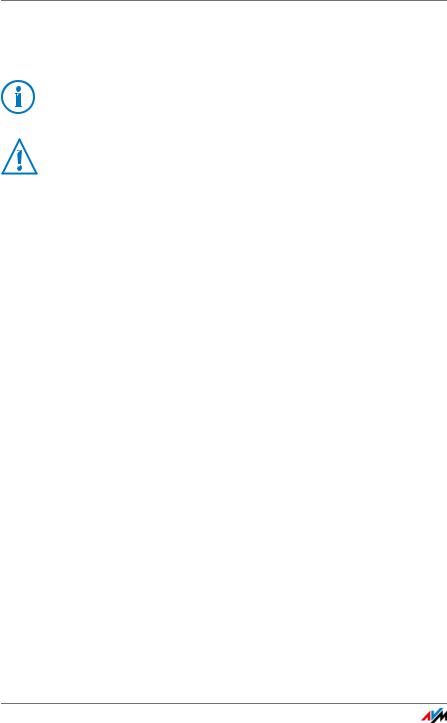
Conventions in the Manual
This manual uses the following symbols and emphases:
This symbol marks useful hints and tips.
This symbol indicates important instructions that must be observed to avoid malfunctions.
•Quotation marks designate elements and features in the user interface and paths.
Example
Select “System/Push Service” and click “Sender”.
•Pointed brackets mark wild cards.
Example
To edit the device called <Name>, click the “Edit” button.
•Bold type in the text emphasizes important words.
Example
Do not leave the page without saving.
•Blue font in the text designates links and references within this manual and addresses to be entered in the browser.
Example
See also the information on page 10.
FRITZ!Box 7430 |
10 |

The FRITZ!Box 7430
1The FRITZ!Box 7430
Welcome! We are pleased you decided on a FRITZ!Box. The FRITZ!Box 7430 is the hub of your home network, connecting your computers and network devices with the Internet. You can operate the FRITZ!Box as an Internet router on a DSL or VDSL line.
The FRITZ!Box is equipped with ports to connect computers, USB devices and a telephone, an answering machine or a fax machine. Additionally, the FRITZ!Box supports the radio technologies wireless LAN and DECT. You can use the FRITZ!Box as a wireless LAN access point for wireless devices like notebooks, tablets or smartphones and as a DECT base station for your cordless telephones.
A connected telephone uses the FRITZ!Box as a PBX.
The FRITZ!Box integrates connected computers and network devices into your private home network. The devices can exchange data with each other and enjoy shared access to USB hard drives, USB printers and other USB devices. The FRITZ!Box transmits music, video and image files to suitable playback devices in the home network.
You can expand the scope of functions of your FRITZ!Box with AVM smart home devices for home automation.
Settings for the FRITZ!Box and for your private network are configured in an easy-to-use user interface. The user interface can be opened in any web browser. Wizards guide you step by step through the setup of the most important FRITZ!Box functions, and comprehensive Help is available on all functions.
This manual assists you in connecting, configuring and operating your FRITZ!Box. Its purpose is not only to introduce to you the many functions of the FRITZ!Box, but also to familiarize you with some of the technical context.
FRITZ!Box 7430 |
11 |
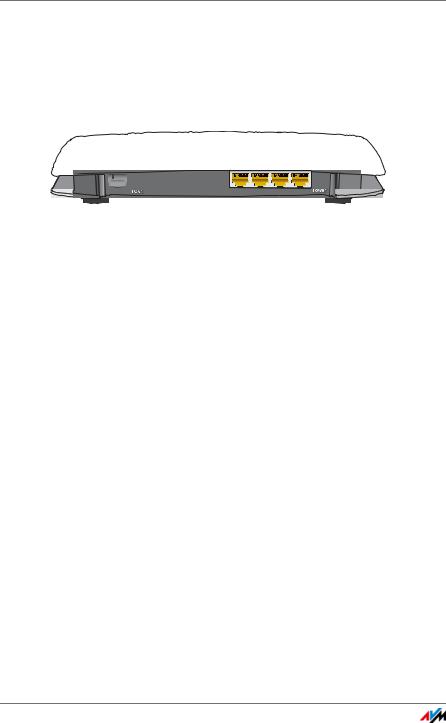
Ports, Interfaces, Buttons and LEDs
2Ports, Interfaces, Buttons and LEDs
This chapter describes the ports, interfaces, buttons and LEDs of the FRITZ!Box.
2.1Ports and Interfaces
Fon analog |
DSL/VDSL |
4 x LAN |
WLAN |
DECT |
USB 2.0 |
|
|
||||
Analog telephone, |
DSL or |
Computer, network |
Notebook, smartphone, |
FRITZ!Fon, |
Printer, |
analog fax |
VDSL line |
game consoles |
video/TVstreaming DECTtelephones |
storage media |
|
Possibilities for connecting the FRITZ!Box
•DSL/TEL
Socket for connecting to ADSL2+ and VDSL
•FON 1
one RJ11 socket for connecting an analog telephone or another analog terminal device
•LAN 1—LAN 4
4 Ethernet ports (10/100 Base-T) for connecting computers and other network devices like game consoles and network hubs
•USB 
USB 2.0 port for connecting USB devices like printers or storage media
•Wireless access point
Integrated wireless access point for connecting to wireless LAN devices that use the radio standard
IEEE 802.11b, IEEE 802.11g or IEEE 802.11n in the 2.4- GHz frequency band
FRITZ!Box 7430 |
12 |

Buttons
•DECT base station
Integrated DECT base station for connecting up to 6 cordless telephones that use the DECT standard
2.2Buttons
The FRITZ!Box has two buttons on the top of the housing.
/ DSL |
|
|
|
|
Powe |
Fon |
DECT |
WLAN |
Info |
FRITZ!Box buttons
Button Functions
“WLAN” Button
•Switches wireless LAN on and off
•Establishes a wireless LAN connection using WPS, see Establishing a Wireless LAN Connection Using WPS from page 24
“DECT” Button
•Registers cordless telephones, see page 49
•Pages cordless telephones, see page 108
FRITZ!Box 7430 |
13 |

Buttons
Locking the Buttons on the FRITZ!Box
You can lock the buttons on the FRITZ!Box. Locking the buttons prevents the settings for your FRITZ!Box or your home network from being changed unintentionally or without authorization.
Example
With the “WLAN” button the wireless network of the FRITZ!Box can be switched off at the touch of a button. If this happens by accident, in some cases it may take some time before the cause is found and the wireless LAN radio network can be restored to all FRITZ!Box users in the home network.
The button lock is configured in the FRITZ!Box user interface, under “System / Buttons and LEDs” on the “Keylock” tab.
FRITZ!Box 7430 |
14 |

LEDs
2.3LEDs
The FRITZ!Box 7430 has five LEDs, which flash or light up to display various connection statuses and events.
For the “Info” LED you can assign any event desired in addition to the preset events. For more information, read Assigning Any Event to the “Info” LED on page 16.
Meaning of the LEDs
LED |
Condition |
Meaning |
Power / |
on |
Device has electrical power and the DSL line is ready for op- |
DSL |
|
eration |
|
|
|
|
flashing |
Device has electrical power and the connection to DSL is |
|
|
being established or has been interrupted |
|
|
|
Fon |
on |
Telephone connection to the Internet is active |
|
|
|
|
flashing |
Messages in your voice mail or e-mail inbox |
|
|
This function must be supported by your telephony provider |
|
|
|
DECT |
on |
DECT function is enabled |
|
|
|
|
flashing |
Registration procedure for a DECT device in progress |
|
|
|
WLAN |
on |
Wireless LAN is enabled |
|
|
|
|
flashing |
• Switching wireless LAN function on or off |
|
|
• Applying changes to the wireless LAN settings |
|
|
• Performing WPS |
|
|
• WPS procedure aborted: More than two wireless LAN de- |
|
|
vices are performing WPS at the same time. Repeat the |
|
|
WPS procedure. |
|
|
|
FRITZ!Box 7430 |
15 |

LEDs
LED |
Condition |
Meaning |
Info |
on |
• Stick & Surf procedure with FRITZ!WLAN USB Stick from |
|
|
AVM concluded |
|
|
• The LED signals an event specified in the user interface |
|
|
under “System / Buttons and LEDs / “Info” Display” |
|
|
|
|
flashing |
• Updating FRITZ!OS |
|
|
• Stick & Surf procedure with FRITZ!WLAN USB Stick from |
|
|
AVM in progress |
|
|
• Signals an event specified in the user interface under |
|
|
“System / Buttons and LEDs / “Info” Display” |
|
|
|
|
flashing red |
Error: |
|
|
• Open the FRITZ!Box user interface; see page 28 |
|
|
• Follow the instructions under “Overview” in the user in- |
|
|
terface |
|
|
|
Assigning Any Event to the “Info” LED
The “Info” LED on the upper panel of the FRITZ!Box signals various events. Some events for which the “Info” LED flashes or lights up are preset in the FRITZ!Box. You also have the option of assigning any other event to the “Info” LED.
1.Open the FRITZ!Box user interface; see page 28.
2.Under “System/Buttons and LEDs”, click the ““Info” Display” tab.
3.In the “Freely Selectable Options” area, select from the ““Info” LED” list the additional event which is to be assigned to the LED.
4.Then click the “Apply” button.
The “Info” LED now flashes not only for the preset events, but also for the event you selected.
FRITZ!Box 7430 |
16 |

Before You Connect the FRITZ!Box
3Before You Connect the FRITZ!Box
•Read the security instructions on page 8.
•Check the contents of your FRITZ!Box package. See page 17 to find out what is included in the package.
•Make sure that the requirements for operating the FRITZ!Box have been met; see page 17.
•Read the handling instructions for your FRITZ!Box on page 18.
•Note the tips for passwords on page 31.
3.1Contents of the FRITZ!Box Package
•FRITZ!Box 7430
•one power supply unit
•one network cable
•one DSL cable
•one quick guide
3.2Requirements for Operation
In order to operate the FRITZ!Box, you must have the following:
•an up-to-date web browser
Some of the FRITZ!Box functions can be used only with a web browser that supports HTML5, for instance Firefox version 17 or higher, Internet Explorer version 9 or higher, or Google Chrome version 23 or higher.
•a connection to the Internet
–DSL line with or without splitter: ADSL/ADSL2/ADSL2+ (also IP-based, Annex J), or alternatively ITU G.992.1, ITU G.992.3 or ITU G.992.5 (Annex B or J)
–or VDSL2 (also IP-based) or ITU G.993.2
–or an Internet cable access with cable modem
FRITZ!Box 7430 |
17 |

Handling the FRITZ!Box
–or a USB modem for mobile Internet access (UMTS/HSPA)
–or another Internet connection
•for the wireless LAN connection to tablets, smartphones and computers:
Tablets, smartphones or computers that support wireless LAN compliant with IEEE 802.11n, IEEE 802.11g or IEEE 802.11b. Computers that do not have wireless LAN integrated can be equipped with wireless LAN support by installing a wireless LAN device, like a
FRITZ!WLAN USB Stick, for instance.
•for connecting computers using network cables:
computer with a network port (network adapter standard Ethernet 10/100 Base-T)
3.3Handling the FRITZ!Box
•Read the Safety Instructions from page 8.
•You can place the FRITZ!Box on a horizontal surface or mount it on a wall. For a drilling template to mount the FRITZ!Box on a wall, see page 171.
•Place or hang the FRITZ!Box in a dry location that is free of dust and protected from direct sunlight.
•For ideal operating conditions, mount the FRITZ!Box on a wall with the cables connected on the bottom.
•When connecting the FRITZ!Box to your computer using a network cable, keep in mind that the cable can be no longer than 100 m.
•If you would like to establish wireless connections between the FRITZ!Box and the computer, position the FRITZ!Box at a central location.
•Make sure to keep sufficient distance from potential sources of interference like microwave devices or electric devices with large metal housings.
FRITZ!Box 7430 |
18 |
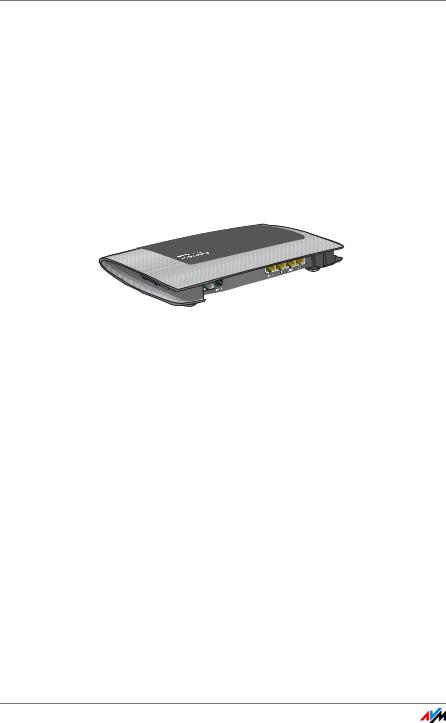
Connecting the FRITZ!Box
4Connecting the FRITZ!Box
•Before you connect the FRITZ!Box, read the instructions on Safety Instructions from page 8.
•Connect the FRITZ!Box to the power supply.
•Connect the FRITZ!Box to your Internet connection.
4.1Connecting to Electrical Power
Connecting to the power supply
1.Pick up the power supply unit included in the FRITZ!Box package.
Use only this power supply unit for connecting to electrical power.
2.Connect the power supply unit to the socket on the FRITZ!Box labeled “Power”.
3.Plug the other end into an AC power outlet.
The “Power / DSL” LED begins flashing after a few seconds to indicate that the FRITZ!Box is ready for operation.
4.2Connecting to the Internet
The FRITZ!Box can be connected using various types of Internet connections:
•DSL/VDSL line
•Internet cable access using a cable modem
•Internet via mobile network
•Internet connection of another router
FRITZ!Box 7430 |
19 |
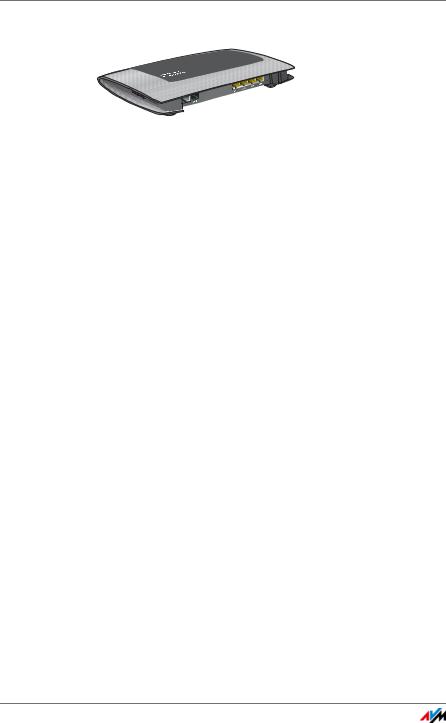
Connecting to the Internet
Connecting to the DSL Line
Connecting to a telephone socket
1.Insert the DSL cable (gray) into the “DSL/TEL” socket on the FRITZ!Box.
2.Insert the free end of the cable into the socket on the DSL splitter labeled “DSL”.
After a short time the “Power / DSL” LED on the FRITZ!Box lights up. The FRITZ!Box is ready to connect to the Internet.
If the “Power / DSL” LED continues flashing, read DSL
Connection Not Established on page 155.
Connecting to the Cable Junction
With an additional cable modem you can also use your FRITZ!Box 7430 on a cable connection. Use a network cable.
1.Connect the free end of the network cable to the LAN (Ethernet) port on the cable modem.
2.Connect the other end of the network cable to the socket on the FRITZ!Box labeled “LAN 1”.
3.Connect a computer with the FRITZ!Box either via wireless LAN or using a network cable; see Connecting a Computer with a Network Cable from page 22 and Connecting Devices with the FRITZ!Box over Wireless LAN from page 24.
4.Set up the Internet connection for connections via cable in the FRITZ!Box; see page 45.
FRITZ!Box 7430 |
20 |

Connecting to the Internet
Connecting to the Internet via the Mobile Network
The FRITZ!Box can also connect to the Internet via the mobile communications network. A mobile telephone and a SIM card from a mobile communications network provider are required for this. The following kinds of connections and mobile communications standards are supported:
•LTE/UMTS/HSPA: The FRITZ!Box supports USB mobile communications dongles for LTE/UMTS/HSPA.
•USB tethering: The FRITZ!Box supports USB tethering. Mobile communications dongles and smartphones that support USB tethering can be used to connect to the Internet via the mobile communications network.
Using a Mobile Communications Dongle
1.Insert the mobile communications dongle into the USB port on the FRITZ!Box.
2.Configure the Internet connection via the mobile communications network; see page 45.
Using a Smartphone with USB Tethering
1.Use a USB cable to connect the smartphone with the FRITZ!Box.
2.Configure the Internet connection via the mobile communications network; see page 45.
Connecting to a Router or a Network
You can use the FRITZ!Box at an already existing Internet access. To do this the FRITZ!Box is connected to the router or network.
A network cable is required to connect the FRITZ!Box to a router.
1.Insert one end of the cable into the socket on the FRITZ!Box labeled “LAN 1”.
2.Insert the other end of the cable into a network socket on the router or in the network.
Once you have connected a computer to the FRITZ!Box, you can configure the Internet connection, see Internet Connection over LAN 1: FRITZ!Box as a Router on page 47.
FRITZ!Box 7430 |
21 |
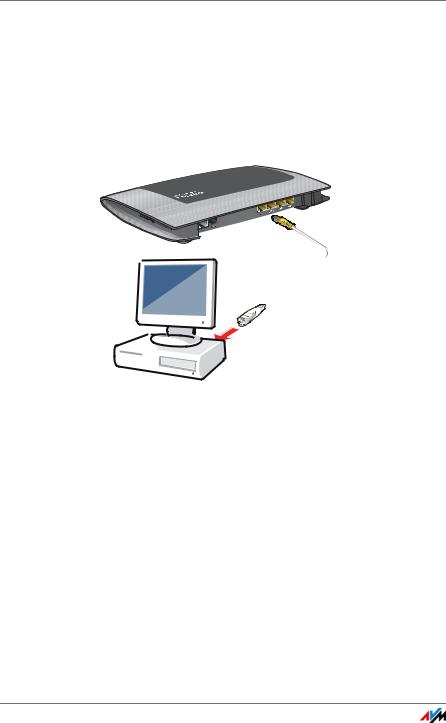
Connecting a Computer with a Network Cable
5Connecting a Computer with a Network Cable
You can connect computers and other network devices with the FRITZ!Box using a network cable.
5.1Connecting to the Computer
One computer or other network device can be connected to each LAN port of the FRITZ!Box.
Connecting a computer using a network cable
1.Insert the network cable included in the package into the LAN port of the computer.
You can also use any other network cable. For more information, see page 164.
2.Insert the free end of the cable into a LAN socket on the FRITZ!Box.
Now the FRITZ!Box and the computer are connected with each other.
FRITZ!Box 7430 |
22 |
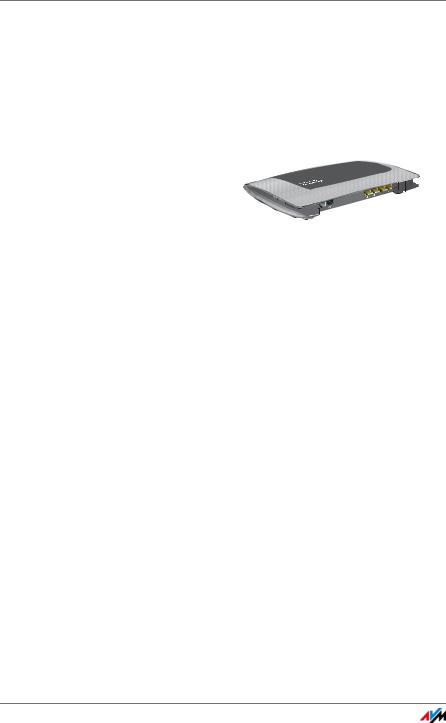
Connecting a Network Hub or Switch
5.2Connecting a Network Hub or Switch
You can connect a network hub or network switch to the
FRITZ!Box.
1.Insert the network cable included in the package into the uplink port of the network hub or network switch.
You can also use any other network cable. For more information, see page 164.
2.Insert the free end of the cable into a LAN socket on the FRITZ!Box.
The FRITZ!Box and the network hub are now connected with each other.
FRITZ!Box 7430 |
23 |

Connecting Devices with the FRITZ!Box over Wireless LAN
6Connecting Devices with the FRITZ!Box over Wireless LAN
Computers and other devices with wireless LAN, for instance smartphones and network printers, can be connected wirelessly with the FRITZ!Box.
You can establish the wireless LAN connection using WPS or by entering the FRITZ!Box network key on the wireless device.
Mobile devices with a camera, like smartphones or tablets, can scan the QR code of the network key to establish a wireless LAN connection.
6.1Establishing a Wireless LAN Connection Using WPS
WPS is a procedure for establishing secure wireless LAN connections. With WPS, connecting a wireless device with the FRITZ!Box is quick and easy.
Requirements
The wireless device must support WPS.
Establishing a Connection on a Windows Computer
Using WPS
Here is how to establish a wireless connection with WPS on a computer with Windows 8.1, 8, 7 or Vista:
1.If the “WLAN” LED on the FRITZ!Box is off, press the “WLAN” button briefly.
The wireless radio network of the FRITZ!Box will be switched on.
2.Open the wireless LAN software on the computer.
In Windows 8.1, 8 and 7, for instance, click the wireless LAN icon  in the task bar.
in the task bar.
3.Select the wireless radio network of the FRITZ!Box.
The preconfigured name of the wireless radio network (SSID) is consists of “FRITZ!Box 7430” and two capital letters, and is printed on the bottom of the housing.
FRITZ!Box 7430 |
24 |
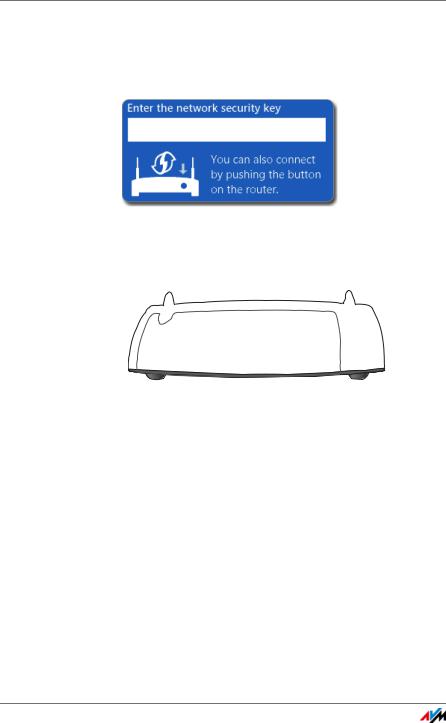
Establishing a Wireless LAN Connection Using WPS
4.Click “Connect”.
The field for the network key appears, along with the information that you can establish the connection by pressing a button on the router:
5.For this step you have two minutes: Press the “WLAN” button on the FRITZ!Box and hold it down until the “WLAN” LED begins flashing.
WLAN
DECT
nfo I
The wireless LAN connection will be established.
Connecting on Other Wireless Devices Using WPS
Here is how to establish a wireless connection with WPS on a wireless LAN device without Windows:
1.If the “WLAN” LED on the FRITZ!Box is off, press the “WLAN” button briefly.
The wireless radio network of the FRITZ!Box will be switched on.
2.Use your wireless device to search for wireless networks in the vicinity.
See the documentation of the wireless LAN device for instructions on how to do this.
FRITZ!Box 7430 |
25 |

Entering the Network Key on the Wireless Device
3.Select the wireless radio network of the FRITZ!Box and start connecting with WPS.
4.For this step you have two minutes: Press the “WLAN” button on the FRITZ!Box and hold it down until the “WLAN” LED begins flashing.
WLAN
DECT
nfo I
The wireless LAN connection will be established.
6.2Entering the Network Key on the Wireless Device
You can establish a wireless LAN connection by entering the FRITZ!Box network key on the wireless device.
The preset network key is printed on the bottom of the housing on the FRITZ!Box. A new network key can be entered in the user interface.
1.If the “WLAN” LED on the FRITZ!Box is off, press the “WLAN” button briefly.
The wireless radio network will be switched on.
2.Open the wireless LAN software on your wireless device. In Windows 8.1, 8 and 7, do this by clicking the wireless
LAN icon 
 in the task bar.
in the task bar.
3.Select the wireless radio network of the FRITZ!Box.
The preconfigured name of the wireless radio network (SSID) is consists of “FRITZ!Box 7430” and two capital letters, and is printed on the bottom of the housing.
4.Click “Connect”.
FRITZ!Box 7430 |
26 |

Connecting to Mobile Devices Wirelessly Using the QR Code
5.Enter the network key of the FRITZ!Box in the wireless LAN software.
6.Start the connection procedure.
6.3Connecting to Mobile Devices Wirelessly Using the QR Code
With mobile devices that have a camera and a QR code reader (app), like smartphones and tablets, you can connect wirelessly by reading a QR code.
1.Open the FRITZ!Box user interface; see page 28.
2.Select “WLAN / Radio Network”.
3.Read the QR code with your mobile device’s QR code reader, directly from the monitor of from a printout.
The mobile device automatically establishes a secure wireless connection to the FRITZ!Box.
FRITZ!Box 7430 |
27 |
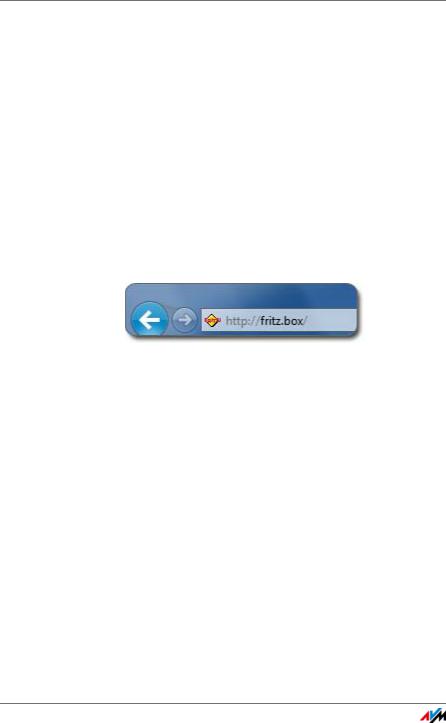
The FRITZ!Box User Interface
7The FRITZ!Box User Interface
The FRITZ!Box has a user interface you can open in a web browser on your computer.
In the user interface you can configure the FRITZ!Box, enable or disable functions and receive information on the FRITZ!Box and on your connections.
7.1Opening the User Interface
The FRITZ!Box user interface can be opened on any computer connected with the FRITZ!Box.
1.Start a web browser on your computer.
2.Enter http://fritz.box in the address field of your web browser.
Entering the address http://fritz.box in the browser
3.Follow the instructions on the screen and enter your FRITZ!Box password.
The preset network key is printed on the bottom of the housing of the FRITZ!Box.
If the user interface is not opened, read the instructions starting from page 155.
7.2Overview: FRITZ!Box at a Glance
All important information about the FRITZ!Box is displayed under “Overview” in the FRITZ!Box user interface.
By clicking the linked entries or “more...” you can jump from the “Overview” page to the corresponding menus and configure settings there.
FRITZ!Box 7430 |
28 |
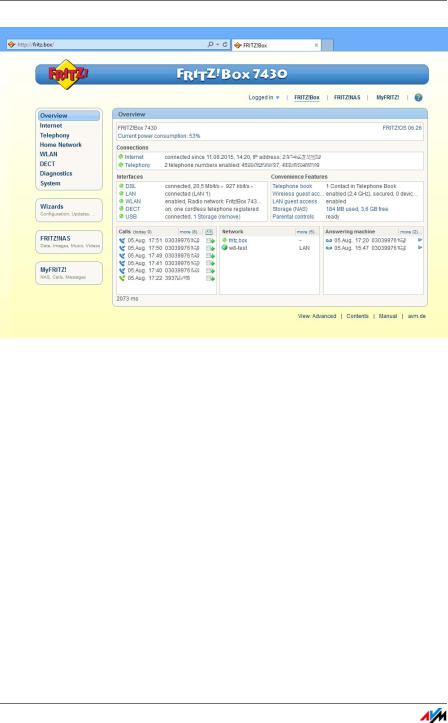
Overview: FRITZ!Box at a Glance
The “Overview” page of the FRITZ!Box
In the upper area of the window the complete name of your FRITZ!Box model is displayed, along with the currently installed version of FRITZ!OS, and its current energy consumption.
Depending on your settings, the following information is displayed here:
•the name you assigned for your FRITZ!Box; see page 31
•the availability of a new FRITZ!OS version for your FRITZ!Box; see page 147.
The middle area of the window presents information about connections and interfaces.
The lower area of the window presents the last calls made, any answering machine messages received, the devices connected in the home network and the enabled convenience features.
FRITZ!Box 7430 |
29 |
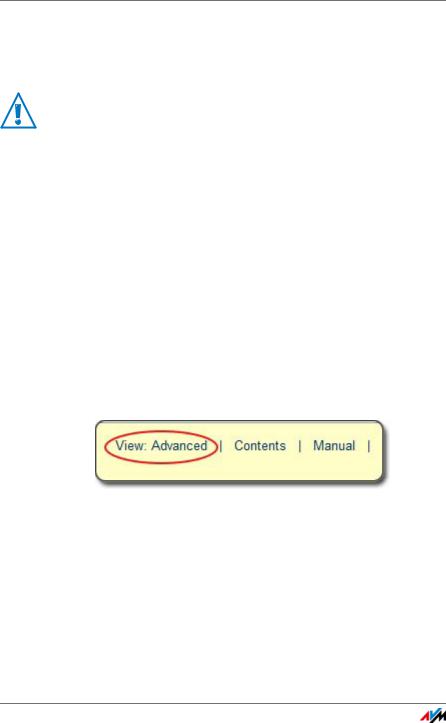
Standard View and Advanced View
7.3Standard View and Advanced View
The FRITZ!Box user interface has two views: the standard view and the advanced view.
Enable the advanced view in the “Internet” and “Home Network” areas only if you have advanced network expertise. Erroneous combinations of settings in these areas can produce a situation in which the user interface of the FRITZ!Box can no longer be opened.
Upon delivery, the FRITZ!Box interface is set to display the standard view. In the standard view all of the settings required for daily operation of the FRITZ!Box are at your disposal. Some pages and areas of the FRITZ!Box user interface are not displayed.
In the advanced view additional settings options appear under various menus and commands. The expanded menu items contain settings for advanced users and are not required for daily FRITZ!Box operation.
Fast Switching between the Views
The “View” link in the link list of the FRITZ!Box allows you to switch immediately between the standard view and the advanced view.
“View” link in the user interface
FRITZ!Box 7430 |
30 |
